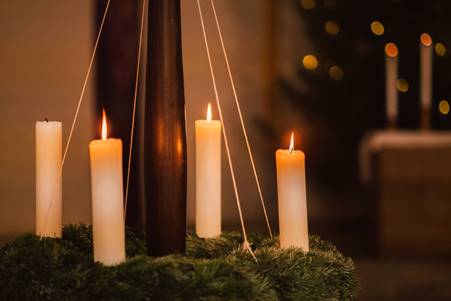
By Jonathan Schops
Advent, in the Christian church calendar, is the preparation period for two things: the celebration of the birth of Jesus Christ at Christmas, and the second coming of Christ.
Christian Advent: Advent translates to ‘coming’ in Latin. It is a Christian countdown to the days until Christmas to symbolically honor the coming of Jesus Christ and his birth into the world. While the adults lead prayer, light candles, and arrange time with one another, the children stay on track with advent calendars.
Timing: Advent begins on the Sunday closest to November 30 (St. Andrew’s Day) and is the beginning of the liturgical year. The celebration of Advent spans the four Sundays leading up to the day before Christmas, beginning on the Sunday that falls between November 27th and December 3rd each year. When a Christmas in on a Wednesday, however, the start of Advent is observed on December 1st. In the United States, Advent is still observed this way; however, in the UK it is more common to start observing the holiday on December 1st. Regardless of location, though, Advent always finishes on Christmas Eve.
Origin: According to Christianity.com, no one is quite sure when Advent was first celebrated, though research states that it began between the 4th and 5th centuries in Spain and Gaul (present day France). Advent served as preparation for the feast of Epiphany, the celebration of God’s incarnation. It is represented by the visit of the Magi to the baby Jesus (Matthew 2:1) and honored with the baptism of new Christians in January.
Ways Advent is Observed:
- Fasting: In many Eastern churches, the Nativity fast is a period of penance occurring the 40 days before Christmas.
- An Advent wreath: May be crafted of pine, natural materials, either homemade or purchased, with candle holders anchored within the wreath.
- Four candles: Placed in the center of the wreath. Each candle is meant to symbolize each of the Sundays in Advent. The fifth candle in the center is traditionally lit on Christmas Day, representing Christ.
- Prayer: Christian families use this time of year to pray together, generally before the evening meal, near the wreath when lighting the candles.
- Advent calendars: Often filled with chocolates or messages, these are hung on the wall or given to young family members to help count down days until Christmas. Although Advent calendars began as a Christian tradition, the secular community has adopted them as part of secular holiday celebrations, and they are now sold with chocolates.
Do you celebrate Advent every year? In what ways do you make the season special? Share your stories with us, we would love to know!
#crossculturalcommunication #cross-cultural #intercultural #accesstoculture #accesstoasia #holidayseason #etiquette #Advent #ChristianAdventexplained #author #diversity
Sharon Schweitzer, J.D., is a diversity and inclusion consultant, cross-cultural trainer, modern manners and etiquette expert, and the founder of Access to Culture. In addition to her accreditation in intercultural management from the HOFSTEDE Centre and the Intercultural Communication Institute, she serves as a Chinese Ceremonial Dining Etiquette Specialist in the documentary series Confucius was a Foodie, on Nat Geo People. She is regularly quoted by BBC Capital, Investor’s Business Daily, and Fortune. Her Amazon #1 Best Selling book in International Business, Access to Asia: Your Multicultural Business Guide, now in its third printing, won a coveted Kirkus Star, and was named to Kirkus Reviews’ Best Books of 2015. She’s a winner of the British Airways International Trade Award at the 2016 Greater Austin Business Awards.

Leave A Comment